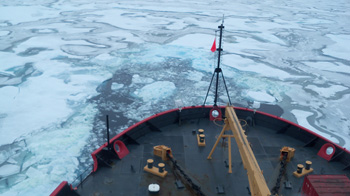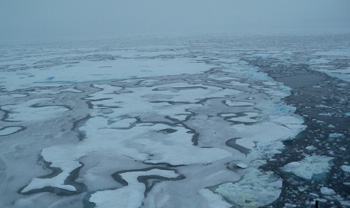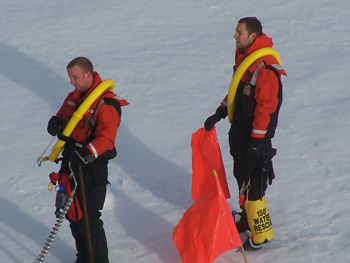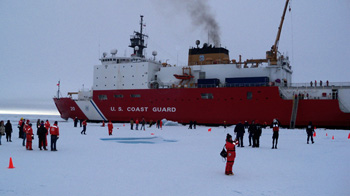Hello Mrs. Pickart's students and thank you for your thoughtful questions. I hope our website encourages you to send us some more before our cruise is ended. Pat Keoughan QUESTION 1 WILL THE ICEBREAKER HARM THE ICE THAT IS ALREADY IN DANGER, CONSIDERING THAT IF YOU BREAK UP THE ICE YOU MAKE MORE SURFACE AREA BE EXPOSED TO THE SUN, THEREFORE MELTING IT QUICKER? Answered by Tom Bolmer, Information Systems Associate II, Science Support: Interesting thought and one we have bounced around before. My thoughts are that no, we don't affect the overall amount of ice in the Arctic as a whole. When the ice is not thick or continuous we pick our way through it and have even less affect on the ice. Often when we are in thick ice that is moving or has a lot of pressure, the ice closes in right behind us and if you look back a mile or so it is hard to believe we just passed an area. I am not a specialist in this topic but my overall impression is that the Arctic is too large to have the overall ice amounts be affected by a few ice breakers working for a few months a year.
QUESTION 2 HOW WILL YOU SPREAD OUT THE FIVE EXPEDITIONS? WILL YOU START THEM OUT CLOSE TOGETHER AND SPREAD THEM OUT OR ARE YOU GOING TO SPACE THEM EVENLY? DO YOU THINK THAT THE TIMING OF THE EXPEDITIONS WILL AFFECT THE DATA COLLECTED IN ANY WAY? DO YOU THINK THAT THERE’S A POSSIBILITY THAT IF YOU DON'T TIME THE EXPEDITIONS RIGHT YOU MAY MISS A CRUCIAL PIECE OF DATA? Answered by Dr. Bob, Chief Scientist: By expeditions, I assume that you mean the different projects being carried out on the cruise. We have quite a diverse group of scientists on the ship, including physical oceanographers, chemists, marine mammal scientists, and a bird observer. It is somewhat of a challenge to fit everything together in a way that allows people to successfully carry out their experiments, yet not waste our precious shiptime (the Healy is very expensive to operate!). As chief scientist one of my duties is to try and make the different operations meld together as efficiently as possible. Sometimes it feels like doing a jigsaw puzzle...I consider different possibilities ahead of time and see which combination of tasks seems most logical. I always need to be one step ahead of the game, planning things several days in advance. However, the science operation is only part of the equation. We have to make sure that the work we are planning to do is acceptable within the ship's constraints. For example, we can't recover moorings in the middle of the night, so we have to do other things such as CTD casts. (A CTD cast is when we lower an instrument package to the bottom and bring it back; the instrument measures conductivity, temperature, and depth. This can be done in the dark, and also in pretty rough weather). I also have to be aware that sometimes the ship can't steam as fast as we'd like, for example we need to go slow when we are in the ice or when it is foggy outside (we've seen lots of fog on this trip!). So you can see that there are many different factors involved in carrying out the different projects, and sometimes we have to make compromises. Thankfully, our operations have fit together very nicely on this cruise, and I think all of the scientists are happy with what we have accomplished.
QUESTION 3 ARE THERE ANY DIVERS GOING INTO THE WATER? Answered by Pat Keoughan, Outreach: There are no dives planned for this cruise. When the Healy stopped and we all had a liberty (free time) on a large ice floe, there were two Coast Guard rescue swimmers on the ice prepared to grab anyone who might fall through. According to MK2 Chris Schumacher, the Coast Guard does have dive crews and they do dive in the Arctic. They come onboard to do a mission but are not stationed on the Coast Guard ships.
QUESTION 4 WHAT ARE YOU COMPARING ALL THE DATA COLLECTED TO? THAT IS, ARE THERE BASELINE MEASUREMENTS AND IF SO, WHEN AND WHERE WERE THESE TAKEN? IN WHAT CONTEXT ARE YOU ANALYZING THE DATA? Answered by Dr. Bob, Chief Scientist: Excellent question. One of the biggest challenges in understanding climate change is that it is happening so quickly, especially here in the Arctic. Ideally, we would like to have a good understanding of the system BEFORE the change starts; in other words, we would like to know what the “baseline” is. With such knowledge we can then quantitatively gauge the extent of the change, which will make it easier to understand exactly why it happened and better predict what the future will bring. As you might suspect, there have been relatively few historical measurements collected in the Arctic (most of them in summer), largely because it is so remote and the conditions are so harsh. Consequently, our baseline knowledge is sparse. As a community we are scrambling to establish an ongoing comprehensive set of measurements to get a better grasp of the baseline as well as the subsequent changes taking place. One example of this is the “Arctic Observing Network”, or AON for short. This consists of different observing systems simultaneously measuring the atmosphere, ocean, land, and cryosphere (do you know what that is?). My own project on this cruise is part of the AON. But as I said, the Arctic is changing so quickly—for example the summertime ice is vanishing at an alarming rate—that in some ways it may be too late to document the baseline. To answer the last part of your question, another key part of understanding the Arctic as a whole is for as many scientists as possible to analyze our data collaboratively. Our hope is that by combining lots of data from various geographical regions and different fields (for example oceanography and meteorology), we’ll be able to understand better how this complex system works.
Last updated: September 29, 2010 | |||||||||||||||||||||
Copyright ©2007 Woods Hole Oceanographic Institution, All Rights Reserved, Privacy Policy. | |||||||||||||||||||||




